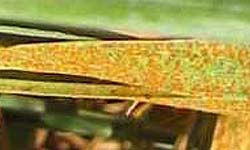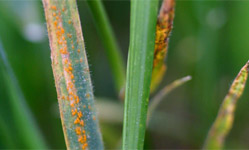Rusts of barley
There are 4 rusts which can attack barley:
- barley leaf rust (Puccinia hordei) is the most common, typically occurring in susceptible varieties in high rainfall regions
- barley stem rust (Puccinia graminis) is less common, but can cause severe crop loss in favourable years
- barley stripe rust (Puccinia striiformis) is currently an exotic disease
- barley grass stripe rust can attack some susceptible barley varieties.
What to look for
Leaf rust

Pustules of leaf rust are small and circular, producing a mass of orange-brown powdery spores predominantly on the upper leaf surfaces.
Later in the season, pustules also develop on leaf sheaths. The pustules easily rub off on a finger. As the crop matures the pustules turn dark and produce black spores embedded in the old plant tissues.
Stem rust

The large pustules are oval to elongated, and are often surrounded by a characteristic torn margin.
Pustules are full of reddish-brown spores which fall away easily. They can occur on stems, leaf surfaces, the leaf sheaths and heads.
As a plant matures, the pustules produce black spores that do not dislodge. Leaf and stem rust may be confused, but they are distinguished by their colour and size. Leaf rust is lighter coloured, smaller and rounder than stem rust.
Stripe rust and barley grass stripe rust
Stripe rust of barley is currently an exotic disease. Symptoms are similar to stripe rust in wheat. These include bright yellow-orange spores that form pustules which occur in stripes along the leaves.
In young leaves, the pustules tend to be scattered across the leaf. Spores rub off easily onto a finger. Barley grass stripe rust and barley stripe rust have the same symptoms. If either disease is suspected, it should be reported to contact the exotic plant pest hotline on 1800 084 881 or contact Agriculture Victoria pathology.

Economic importance
Stem rust is potentially the most devastating disease of the three rusts, as it is able to cause complete crop loss. However, suitable conditions for a severe outbreak are rare.
Early infections of leaf rust can result in significant yield losses of up to 30%. Yield loss from barley grass stripe rust is rare, but can be as high as 20% in susceptible varieties in some years.
If barley stripe rust, which is currently an exotic disease, is introduced to Australia it will cause severe losses in many varieties.
Disease cycles
Leaf rust
In most cases, leaf rust requires green volunteer barley plants to survive over summer, and infect new crops the following autumn.
However, in areas where the weed Star of Bethlehem (Ornithogalum umbellatum) occurs, the black teleutospores are able to infect this plant and undergo a sexual reproductive cycle producing a new generation of spores to re-infect barley. The existence of a sexual cycle means the formation of new strains of rust, thus increasing the chance of the rust overcoming current resistances.
Currently Star of Bethlehem is more common in South Australia, but there are isolated occurrences in the Victorian cropping zone. Its potential as a host should not be ignored.
Development of the disease is most rapid during warm (15 to 20°C) moist (rain or dew) weather.
Crops sown early, when nights are still warm, are often more severely infected.
Stem rust
Stem rust survives the summer mainly on volunteer wheat, barley, triticale and some grasses including common wheat grass and barley grass. Spores are spread from these hosts to the new crop by wind.
High humidity and heavy dew favour disease development. It is most rapid at temperatures between 15 to 30°C and is markedly reduced by temperatures below 15°C and above 40°C.
Wet summers cause growth of self-sown wheat, barley and other hosts of stem rust. These plants can become heavily infected with stem rust in the autumn, and be a source of rust for the new season's barley crop.
If these conditions are followed by a mild winter and a warm wet spring, the chances of a stem rust epidemic are high.
Barley grass stripe rust
Barley grass stripe rust survives over summer on self sown barley, and barley grass.
Since barley grass stripe rust was only first reported in Australia in 1998, little is known about the conditions that favour infection.
Management
Resistant varieties
The most effective way to control the rusts of barley is to grow varieties with resistance or avoid growing those that are rated as very susceptible or susceptible to each disease.
Even growing moderately susceptible varieties will significantly reduce the potential yield loss from rusts.
To select varieties with resistance, it is essential to consult a current Cereal disease guide.
Rusts are able to produce new races which are capable of attacking varieties that were resistant when they were first released.
Resistant varieties not only reduce the amount of disease in a crop, and therefore the yield loss, but they also reduce the chance of the rusts mutating, enabling them to attack previously resistant varieties.
Cultural practices
Barley rusts survive predominantly on self-sown barley over summer, so it essential to remove this source of inoculum. Use of heavy grazing or herbicides to remove green growth is important, especially following wet summers.
Seed treatment
There are no seed treatments registered for rust control in barley. However, seed treatments are necessary to control bunts and smuts, as well as other barley diseases.
Foliar fungicides
There are a range of foliar fungicides available that will give disease suppression of leaf rust in barley.
For the best suppression, apply foliar fungicides when leaf rust is first detected. Additional applications may be necessary when the season is favourable for rust diseases.
Further references
Rust identification
For rust identification, send rusted plant samples in a paper envelope (do not use plastic wrapping) to:
Australian Cereal Rust Survey
Plant Breeding Institute
Private Bag 4011,
Narellan NSW 2567
Contact
Dr Grant Hollaway
Dr Mark McLean
Cereal Pathologists – Horsham
03 5450 8301
Field Crops Pathology
Grains Innovation Park
110 Natimuk Rd
Horsham 3400
03 5450 8301
Or call the Customer Service Centre, 136 186
Image credits
Figure 1 courtesy R. Park
Acknowledgements
Mark Mclean, Grant Hollaway, Frank Henry (Farm Services Victoria). Support by the Grains Research and Development Corporation is gratefully acknowledged.